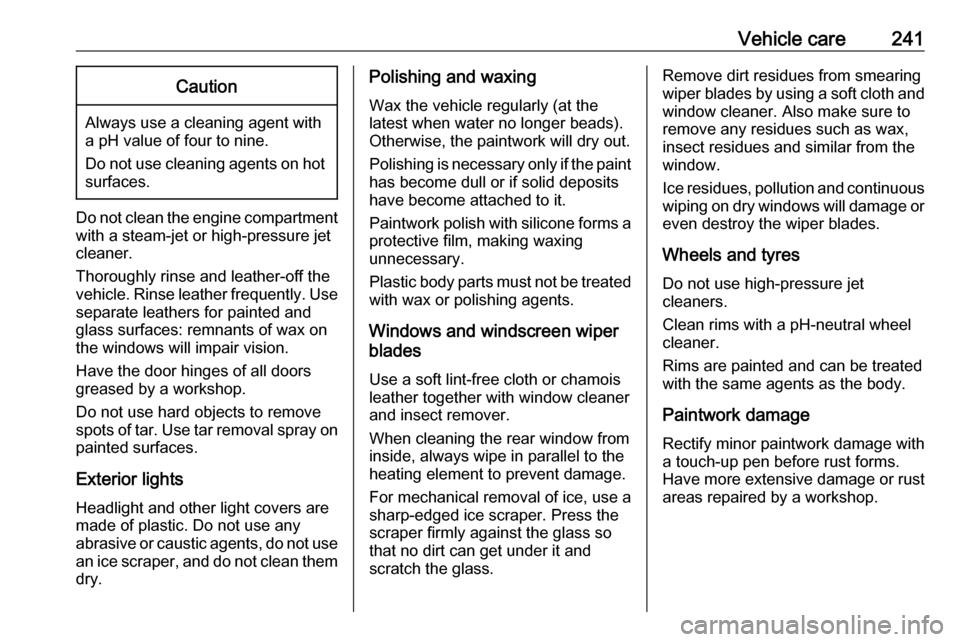engine OPEL AMPERA E 2017.5 Manual user
[x] Cancel search | Manufacturer: OPEL, Model Year: 2017.5, Model line: AMPERA E, Model: OPEL AMPERA E 2017.5Pages: 265, PDF Size: 6.24 MB
Page 240 of 265

238Vehicle care● Use a booster vehicle batterywith the same voltage (12 Volt).
Its capacity (Ah) must not be much less than that of the
discharged vehicle battery.
● Use jump leads with insulated terminals and a cross section of
at least 16 mm 2
.
● Do not disconnect the discharged
vehicle battery from the vehicle.
● Switch off all unnecessary electrical consumers.
● Do not lean over the vehicle battery during jump starting.
● Do not allow the terminals of one
lead to touch those of the other
lead.
● The vehicles must not come into contact with each other during
the jump starting process.
● Apply the parking brake, shift lever in P.
● Open the positive terminal protection cap of both batteries.Battery terminals in the engine
compartment
The battery terminals to jump start the
vehicle are located in the engine
compartment.
The positive battery terminal is
located below a cover. Open the
cover before jump starting the
vehicle.
The negative battery terminal is stud
on a bracket located near the charger
modules.
Jump starting the vehicle
Lead connection order:
1. Connect the red lead to the positive terminal of the booster
vehicle battery.
2. Connect the other end of the red lead to the positive terminal of
your vehicle.
3. Connect the black lead to the negative terminal of the booster
vehicle battery.
4. Connect the other end of the black
lead to the negative battery
terminal (stud).
Page 241 of 265

Vehicle care239Route the leads so that they cannot
catch on rotating parts in the engine
compartment.
To start the vehicle: 1. Start the engine of the vehicle providing the jump.
2. After five minutes, press POWER m to switch on the
vehicle.
After the instrument cluster
initialises, the vehicle will use
power from the high voltage
battery to charge the 12-volt
battery.
3. Switch on electrical consumers (e.g. headlights, heated rear
window) of the vehicle receiving
the jump start.
4. Reverse above sequence exactly when removing leads.Towing
Towing the vehicleCaution
Incorrect towing of a disabled
vehicle may cause damage to the
vehicle. The disabled vehicle
should only be towed on a flatbed
car carrier.
Ensure the vehicle is only towed
by well trained technicians.
Insert a screwdriver in the slot at the
short edge of the cap. Release the
cap by carefully moving the
screwdriver sidewards. To prevent
damage, it is recommended to place
a cloth between the screwdriver and
the frame.
The towing eye is stowed with the vehicle tools 3 230.
Screw in the towing eye as far as it will
go until it stops in a horizontal
position.
Attach a tow rope – or better still a tow
rod – to the towing eye.
The towing eye must only be used for towing and not for recovering the
vehicle.
Page 243 of 265

Vehicle care241Caution
Always use a cleaning agent with
a pH value of four to nine.
Do not use cleaning agents on hot surfaces.
Do not clean the engine compartmentwith a steam-jet or high-pressure jet
cleaner.
Thoroughly rinse and leather-off the vehicle. Rinse leather frequently. Use
separate leathers for painted and
glass surfaces: remnants of wax on
the windows will impair vision.
Have the door hinges of all doors
greased by a workshop.
Do not use hard objects to remove
spots of tar. Use tar removal spray on
painted surfaces.
Exterior lights
Headlight and other light covers are
made of plastic. Do not use any
abrasive or caustic agents, do not use an ice scraper, and do not clean them
dry.
Polishing and waxing
Wax the vehicle regularly (at the
latest when water no longer beads).
Otherwise, the paintwork will dry out.
Polishing is necessary only if the paint
has become dull or if solid deposits
have become attached to it.
Paintwork polish with silicone forms a
protective film, making waxing
unnecessary.
Plastic body parts must not be treated with wax or polishing agents.
Windows and windscreen wiper
blades
Use a soft lint-free cloth or chamois
leather together with window cleaner and insect remover.
When cleaning the rear window from
inside, always wipe in parallel to the
heating element to prevent damage.
For mechanical removal of ice, use a
sharp-edged ice scraper. Press the
scraper firmly against the glass so
that no dirt can get under it and
scratch the glass.Remove dirt residues from smearing wiper blades by using a soft cloth and window cleaner. Also make sure to
remove any residues such as wax,
insect residues and similar from the
window.
Ice residues, pollution and continuous
wiping on dry windows will damage or even destroy the wiper blades.
Wheels and tyres
Do not use high-pressure jet
cleaners.
Clean rims with a pH-neutral wheel
cleaner.
Rims are painted and can be treated
with the same agents as the body.
Paintwork damageRectify minor paintwork damage with
a touch-up pen before rust forms. Have more extensive damage or rust
areas repaired by a workshop.
Page 248 of 265

246Technical dataTechnical dataVehicle identification..................246
Vehicle Identification Number ..246
Identification plate ...................246
Vehicle data ............................... 248
Performance ............................ 248
Vehicle weight ......................... 248
Vehicle dimensions .................249
Tyre pressures ........................ 250Vehicle identification
Vehicle IdentificationNumber
The Vehicle Identification Number
may be embossed on the instrument
panel, visible through the windscreen, or in the engine compartment on the
right body panel.
The Vehicle Identification Number
may be stamped on the identification
plate, or in the engine compartment on the body panel.
Identification plate
The identification plate is located on
the front left or right door frame.
Page 259 of 265

257Initiating a phone call..............137
Ring tone ................................. 137
Call history .................................. 137
Car wash mode .......................... 155
Central locking system ................20
Centre console storage ...............59
Changing tyre and wheel size ...235
Charge cord ................................ 205
Charge limit selection .................197
Charge mode selection ..............197
Charge rate selection .................197
Charging ..................................... 193
Charging override .......................197
Charging status .......................... 204
Charging system .......................... 79
Child locks ................................... 26
Child restraint installation locations ................................... 54
Child restraints.............................. 52
Child restraint systems ................52
Climate control ............................. 13
Clock............................................. 69
Collision damage repair ..............251
Control elements Infotainment system ................108
Steering wheel ........................ 108
Control elements overview .........108
Control indicators.......................... 78
Control of the vehicle .................149
Controls ........................................ 66Convex shape .............................. 31
Coolant ....................................... 214
Coolant and antifreeze ...............244
Cooling system ........................... 214
Cruise control ...................... 82, 164
Cupholders .................................. 58
Curtain airbag system .................. 50
D DAB ............................................ 124
Danger, Warnings and Cautions ...2
Daytime running lights ...............102
Declaration of conformity ............251
Delayed locking ............................ 25
Digital audio broadcasting ..........124
Directional tyres .......................... 230
Displaying pictures .....................130
Display settings ..................130, 131
Door open .................................... 83
Doors ............................................ 28
Drive modes ............................... 154
Driver assistance systems ..........164
Driver Information Centre .............83
Driving economically................... 148
Driving efficiency gauge ...............75
Driving hints ........................ 148, 149
E Electric adjustment ......................31
Electrical requirements ...............208
Electrical system......................... 222Electrical system overload .........222
Electric drive unit ..................14, 155
Electric parking brake ...........80, 159
Electric parking brake fault ...........80
Electric rate schedule .................197
Electric vehicle operation modes 154
Electronic climate control system 142
Electronic key system ...................19
Electronic Stability Control.......... 163
Electronic Stability Control and Traction Control system ............81
Electronic Stability Control off....... 81
Emergency call ........................... 136
Engine compartment fuse box ...224
Entry lighting .............................. 104
Event data recorders ..................254
Exit lighting ................................ 104
Exterior care .............................. 240
Exterior light ................................. 82
Exterior lighting ......................10, 99
Exterior mirrors ............................. 31
F
File formats Audio files................................ 126
Movie files ............................... 126
Picture files.............................. 126
First aid kit ................................... 62
Fixed air vents ........................... 146
Folding mirrors ............................. 32